On 24 January 2025, the Galerie Noah in Augsburg, under the direction of Wilma Sedelmeier, opened the Heisig Year 2025 with the exhibition ‘Bernhard Heisig – 100 Years’. The work of probably the most famous artist of the former GDR is being honoured on the occasion of his 100th birthday on 31 March. Bernhard Heisig (1925-2011) was a co-founder of the Leipzig School and is considered one of the most important representatives of art in the GDR. He had a decisive influence on the German art landscape. His work spans an impressive period from the post-war period to the 21st century. Prof. Dr Bernd Lindner spoke at the opening ceremony on 23 January 2025. In his speech, the Leipzig cultural historian and cultural sociologist, as well as a proven expert on the Leipzig School, emphasised the extraordinary significance of Bernhard Heisig for German art history and elaborated on his multifaceted personality. With concise examples and quotations, Lindner draws a multi-layered picture of Bernhard Heisig and his inner contradictions. His remarks bring to life the deep connections between Heisig’s life and work. We are publishing the text of the speech here.
Image above: Prof. Dr. Bernd Lindner, photo: Christine Starke, Dresden
‘Dear ladies and gentlemen, dear Mrs Sedelmeier and Mrs Winterberg, dear Mr Walter, dear friends of art.
This year, we are honouring Bernhard Heisig, a centenary artist. And not only because the painter and graphic artist would have turned one hundred years old on 31 March 2025 and had to live through significant ruptures and events in German history in the 20th century at close quarters in his biography, but also because he played a decisive role in shaping the visual arts of this centenary in Germany.
Born on 31 March 1925 in Breslau and deeply influenced by nightmarish war experiences as a soldier in the Second World War, he lived and worked in Leipzig and the GDR from 1948 – whose 40-year existence he helped to shape with both commitment and criticism – before he died on 10 June 2011 in reunified Germany (in Strohdehne in Brandenburg’s Havelland region).
As dissonant as social developments were in the 86 years of his life, Bernhard Heisig remained unwavering in his artistic work – and here I quote him myself – ‘the human figure’ as ‘the painter’s most expressive medium’. The way in which he constantly redesigned the human figure and worked on it – painting after painting – puts him on a par with Max Beckmann, Oskar Kokoschka, Otto Dix, Karl Hofer, but also Käthe Kollwitz, to name just the most important reference figures of his work in modern German art. All of them were realists who, as figurative artists with large social panoramas as well as subtle portraits and pictorial parables, had a decisive influence on the art of the 20th century.
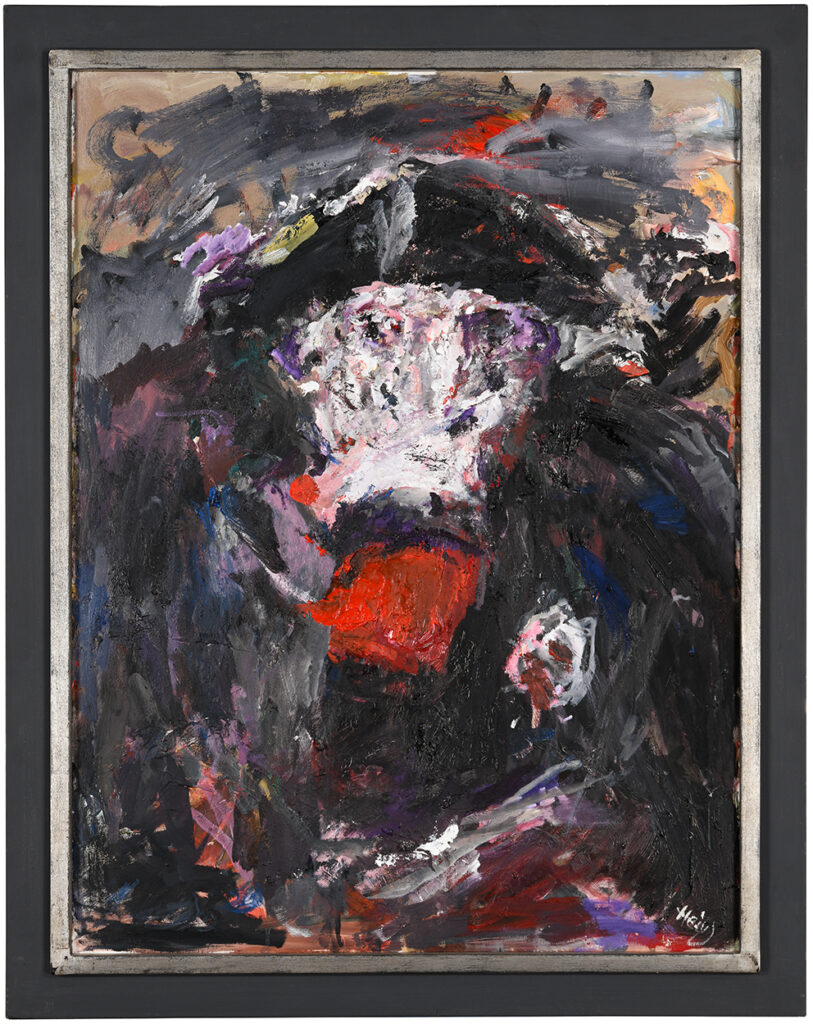
However, this does not mean that Bernhard Heisig only accepted the realistic image of man in the visual arts. On the contrary: he repeatedly risked his artistic existence in the GDR because he took a public stand against the dogmatic narrowness of political guidelines in art – as they dominated the first two decades of this state in particular. As early as 1964, at the V Congress of the Association of Visual Artists, he spoke out against the tabooing of Western art movements by SED cultural policy: because – as Heisig put it – ‘anxiously shielded against all influences of Western modernism, (the artist) suffers from a kind of conceptual deformation’, in that he ‘on the one hand overvalues the forbidden and therefore particularly attractive fruits, on the other hand becomes artistically unfit for life and takes refuge in a desolate provincialism.’
‘The artist is also a critic of his time. Where this is not accepted, society loses a regulator.’
Bernhard Heisig
According to Heisig, artists must be able to deal with Western modernism ‘on their own responsibility’ and not be told by state institutions alone ‘what is spiritually acceptable for them and what is not’. Realism must address the whole person, ‘his joys, his desires, his longings, his dreams, but also his tragedy and his fear, his imperfection, his suffering, his life. Life and death are the subject of artistic exploration. Here, too, nothing must be suppressed.’ Because an idealised construct of man as a ‘model of socialist perfection’ would be a ‘disgusting frame’, Heisig said verbatim. And he continued: ‘The artist is also a critic of his time. Where this is not accepted, society loses a regulator.’
The SED did not put up with such a frontal attack on its narrow-minded cultural policy. Party proceedings were immediately initiated against ‘Comrade Heisig’, at the end of which – in the style of the time – he was forced to criticise himself, just as the Halle painter Willi Sitte had done before him for his Picasso-esque painting style. Heisig received a ‘severe party reprimand’ and had to resign from his post as Rector of the Leipzig Academy of Visual Arts (HGB), which he had only taken up in 1961.
However, he had made good use of the previous three years and purposefully set up a specialised painting class at the university, which was actually intended to train the next generation of artists for the GDR publishing houses (typographers, illustrators, photographers, etc.). Even though Hartwig Ebersbach, a student of Heisig’s since 1959, was instrumental in setting up the painting class, it is fair to say that without Bernhard Heisig, the ‘Leipzig School’ that later became famous – which is also represented in the collection of the Kunstmuseum Walter with over 45 excellent works, 17 of them by Bernhard Heisig alone – would not have existed in both senses of the word:
Firstly, because Heisig created the spatial and structural conditions for the ‘Leipzig School’ and
Secondly, because he – alongside Wolfgang Mattheuer and Werner Tübke – was one of the three figureheads of this extremely heterogeneous and perhaps precisely for this reason so successful organisation: three painters ‘in one city, in one university … as the cornerstones of a field of strength and work’, as the publicist Friedrich Dieckmann described it.
But first Bernhard Heisig resigned from his teaching position at the HGB in 1968 because he could no longer stand the increasing dogmatism at the school and preferred to work freelance.
When he was reappointed rector of the HGB in 1976, this was also thanks to the great success that the ‘Leipzig School’ had achieved, not only in the GDR but also far beyond.
Before that, however, he experienced years of fear and (self-)doubt. He, who had already begun an unprecedented painterly exploration of failed proletarian uprisings in modern European history in 1953 with ‘Aufbahrung der Märzgefallenen’ (Laying out the March Fallen), was confronted with massive criticism from SED-controlled art critics in the mid-1960s in view of his first painting on the Paris Commune. The party leadership wanted the ‘heroic Commune’ of 1871, its ‘immortality despite defeat’, to be celebrated. Heisig, on the other hand, would ‘focus (solely) on the tragic side of the Commune’. And indeed, Heisig’s expressively painted commune pictures showed multiple variations of failure: Balls of human bodies. Screaming mouths. Hopeless figures on the barricades, aware of their imminent downfall and yet throwing themselves against the bayonets of their overpowering opponents. All desperate confessions of an artist – who struggled to maintain his Marxist world view in the face of the revelation of Stalinist atrocities at the XX Party Congress of the CPSU in 1956 and the bloody suppression of reform efforts in Hungary in the same year, as well as the construction of the Berlin Wall in 1961. (The second ideology of his life, which threatened to fail after his youthful commitment to National Socialism, which had led him to the Waffen SS).
Fearing possible consequences, Bernhard Heisig destroyed or painted over all early versions of his Commune paintings between 1964 and 1967. It was only a four-part painting on the same theme (created in 1970/71), which involved many compromises, that was celebrated by art critics at the VII Art Exhibition of the GDR in Dresden in 1972/73. For the artist himself, however, it represented ‘a compendium of artistic indecisions’, which he would later have liked to ‘destroy’. But by then it had long been part of the collection of the Leipziger Bildermuseum
However, Heisig remained a painter of large historical panoramas, in which he collaged figures from many centuries into our contemporaries, but also linked them closely with his own person and biography, as in ‘Festung Breslau (Fortress Breslau)’ (1972-78), ‘Preußischer Soldatentanz (Prussian Soldier Dance)’ (1978-86), ‘Als ich die Völkerschlacht malen wollte (’When I wanted to paint the Battle of the Nations…’) or “Fritz und Friedrich” (1986-88). He also did not shy away from giving the crucified man his face in the painting ‘Christus verweigert den Gehorsam (Christ refuses to obey)’ (1986/87).
The dates on which these paintings were created reveal that Heisig often took a long time to consider them ‘finished’.
Sometimes – to the dismay of curators and gallery owners – he often continued to paint on pictures that were already hanging in exhibitions.He also varied his themes again and again and revisited them in other pictorial contexts. For example, ‘Icarus’ (painted in 1975/76 for the Galerie im Palast der Republik) became ‘Dying Icarus’ two years later, after Wolf Biermann was expelled from the GDR.
In the exhibition opening today, you too can follow this restless, decades-long work on his pictorial material.
For example, the gas-mask-like portrait of ‘Alter Fritz’ (from 2009), in which Bernhard Heisig transplants the Prussian king into the trenches of the First World War. Or the paintings ‘’Trompetentanz‘’ (Trumpet Dance) and ‘’Der schwarze Geiger‘’ (The Black Violinist) (both from 2008), which take up excerpts of the apocalyptic events in Heisig’s early Commune paintings or the painting ‘’Die erste Bürgerpflicht‘’ (The First Civic Duty) (from 1977) and push them further stylistically.
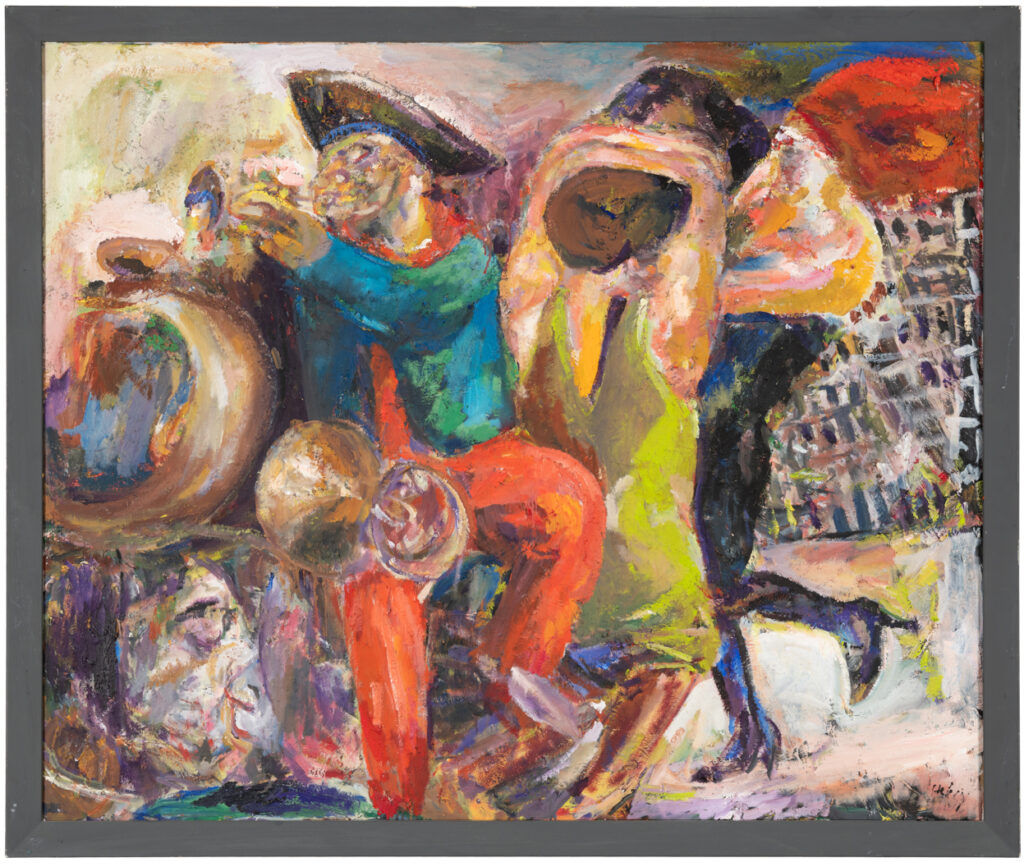
Just as Bernhard Heisig was preoccupied with the myth of the Tower of Babel throughout his life. ‘Neues vom Turmbau (News of the Tower of Babel)’ (1977) is his best-known painting. The story from the Old Testament tells of the Babylonian confusion of languages that God unleashed on the megalomaniac builders of the tower when they wanted to build it up to the heavens. Heisig used the story ‘as a metaphor for civilisation, as a symbol of mankind’s heaven-storming aspirations and self-empowerment’, as the Erfurt art historian Kai-Uwe Schierz emphasised. This is probably why he has an Icarus-like figure in black robes (together with a biplane) crashing in the painting against the backdrop of the unfinished tower.
‘Neues vom Turmbau zu Babel’ (News from the Tower of Babel) is also the title of a painting shown here in this exhibition. It was created in 2011, the year of Heisig’s death, making it one of the last paintings he left us. The unfinished Tower of Babel also forms the backdrop in this painting. However, it is dominated by the large, faceless figure of a crucified man, whose posture is more reminiscent of a stuffed scarecrow than Jesus Christ. Dressed in a black tailcoat and bright red trousers, it appears to be floating in space (as there is no cross to be seen). It also remains unclear whether the barefoot male figure is ascending to heaven or sinking to the ground. In any case, it appears exhausted and powerless: the swansong of a painter in a former (state) function?
Bernhard Heisig, who had previously been unanimously celebrated in the West (even the former German Chancellor and Expressionism lover Helmut Schmidt had his portrait painted for the gallery in the Federal Chancellery in 1986), was defamed as a ‘state artist’ soon after the fall of the Wall. A long-planned Heisig exhibition with over 400 works had only just opened in West Berlin on 30 September 1989 (as part of the German-German cultural agreement), when the assessment of his work turned into the opposite: the start of the German-German picture dispute that lasted for over a decade. This escalated once again in 1997 when the Art Advisory Council of the German Bundestag commissioned Bernhard Heisig to paint a picture for the remodelled Reichstag. Heisig gave his large-format (around six metres long and one and a half metres high) frieze on German history the title ‘Time and Life’. The painting is teeming with pictorial quotations from art and contemporary history, but above all from Heisig’s own pictorial world. The crucified man in the black robe is also a dominant figure. Here he is seen from behind, wedged into a prison-like lattice window. (In some interpretations, he is interpreted as an Eastern European Jew in a caftan). The word ‘duty’ (as a core Prussian virtue) appears several times on the banners shown in the picture. Another banner, which can only be read in fragments, reads: ‘…you die for yourself, your service will be cancelled…’.
Black and red is the colour of the crucified man from ‘News of the Tower of Babel’. Only the gold is missing and the colour sequence of the German national flag would be complete. This is the case with the ‘Fensteröffner’ (Window Openers) that were added to Heisig’s pictorial world at the end of 1989. By 2003, he had painted at least eight such window pictures, which show men jubilantly pushing open a window. They are dressed in golden yellow waistcoats with red and black piping. Nationally-minded petty bourgeoisie with their chests swelling with pride, although they only dared to stick their heads out of the window when the state security forces had long since capitulated to the demonstrators on the streets of Leipzig and elsewhere and the Wall had fallen. Heisig made no secret of his disgust at this renewed followerism. This was also evident in the panopticon of his compatriots that he unfolded in 1990/91 in ‘Menschen am Fenster und Blaues Schiff’. In it, they exuberantly greet the fluorescent airship, reminiscent of the longing motif of the Romantics’ Blue Flower, which they try to catch as it floats past them out of reach. While ‘Pirate Jenny’, in the song of the same name from Brecht’s Threepenny Opera, has long been aware of their futile hopes, because ‘They still don’t know who I am.’
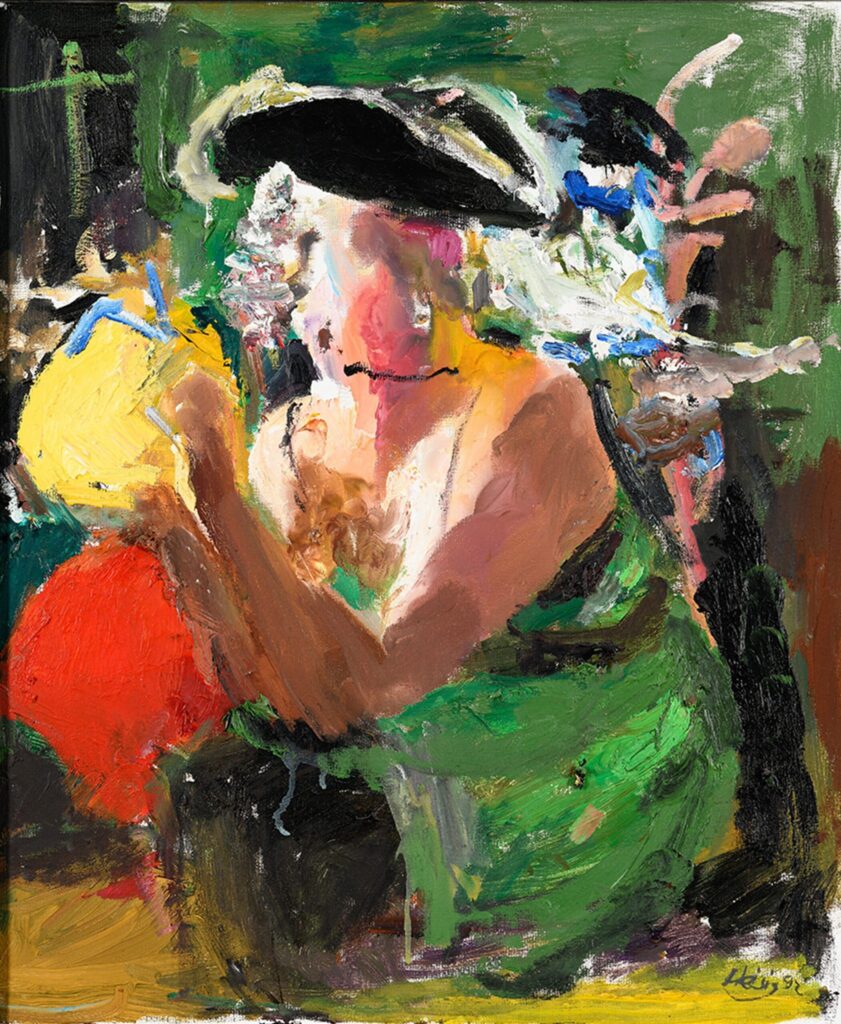
Heisig’s ‘Fensteröffner’ from 2008, which you can see in this exhibition (alongside a pen and ink drawing of the same motif), is still illuminated in blue by the reflection of the dream ship, which has long since disappeared on the horizon.
In addition to painting major social themes, you can also experience Bernhard Heisig here at Galerie Noah as a portraitist of important historical artistic personalities: From the Leipzig über-musician Johann Sebastian Bach to the poet prince Theodor Fontane from the Mark Brandenburg, where Heisig found his retirement home.
‘It is not permissible to overlook the fact that a lot of injustice happened. It should have been known and nothing should have been suppressed, and I blame myself for the latter.’
Bernhard Heisig
His fellow painter from Halle and long-time president of the GDR Association of Visual Artists, Willi Sitte, who Bernhard Heisig supported as vice president from 1974 to 1988, also appears twice in the pictures. As painters – two ‘alpha animals’ – their relationship was often not without tension. Their view of the GDR also differed after its end: while Sitte never renounced his communist ideas and was convinced until his death (two years after Heisig) that he had done nothing wrong, but felt betrayed by the workers in the former workers‘ and farmers’ state, Heisig resigned from the SED in autumn 1989 and returned his two GDR national prizes (which he had been awarded in 1972 and 1978) and used the prize money to set up a foundation for students of fine arts. A handwritten note (undated) was found in his estate:
‘It is not permissible to overlook the fact that a lot of injustice happened. It should have been known and nothing should have been suppressed, and I blame myself for the latter.’
The first Sitte portrait can be found on the oil painting ‘Heinrich Mann – Der Untertan’ from 2005, which shows two portraits: On the left, an almost bald man with a paintbrush in his hand peers out from behind a golden picture frame. His cheerful likeness is very similar to that of Willi Sitte. He looks mischievously at the second face in the painting.
It can be seen on the right of Heisig’s picture in the section. At eye level with the Sitte portrait, a uniformed man in a Prussian soldier’s coat looks out at us from there. However, he looks more like the Captain of Köpenick than the opportunistic petty bourgeois Diederich Hessling, the main character in Heinrich Mann’s novel ‘The Subject’. A book that Bernhard Heisig knew very well, having illustrated it for Büchergilde Gutenberg in 1992. So coincidence is out of the question. Rather, we are dealing with a synonymous double portrait of the artist and loyal ‘party soldier’ Willi Sitte.
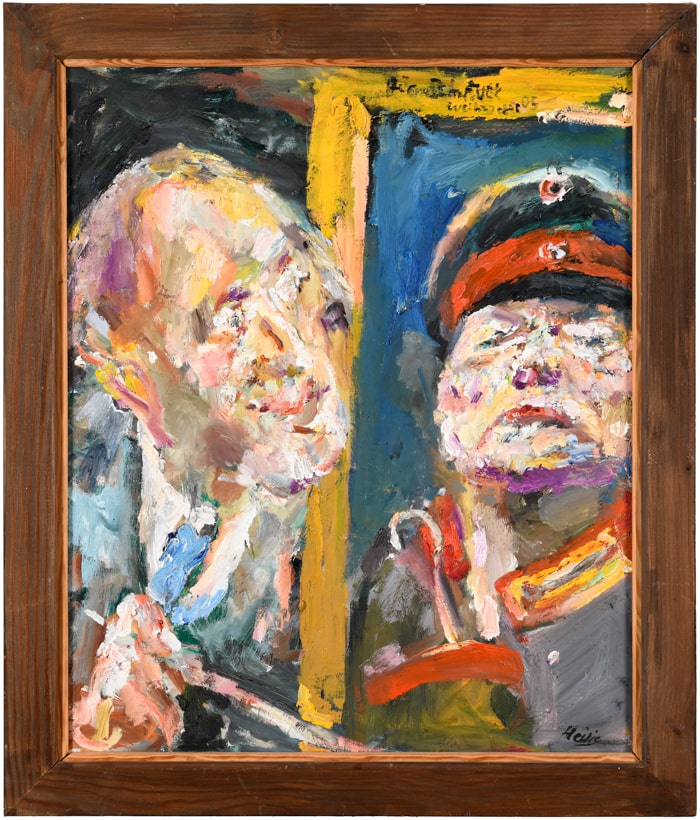
Five years later, Heisig portrayed Willi Sitte again in the painting ‘’Der Maler II (The Painter II)‘’. Now the mockery has given way to pity. We see a seemingly powerless, greying old man, who is supported more by the painting surface on his easel than by holding it with both hands. In the background is a painting of a portrait of a bald man in blue and white striped prisoner’s clothing. Stripes that continue seamlessly on the painter’s green and white striped collar. It has not been possible to determine whether the image in the picture is a painting by Sitte.
Bernhard Heisig often practised the picture-within-a-picture principle. This can be seen here in the painting ‘The collector Mrs Köster and the painter Antoinette’ from 2003. Both women are standing in front of Heisig’s painting ‘The Endgame’, which you can also see here in the exhibition. Antoinette was Heisig’s master student in the 1990s and was married to his son, the painter Johannes Heisig, for a time. In the foreground, however, the painter has painted a portrait of himself.
As he often painted himself. And so you will also find his portrait several times in this exhibition: symbolically charged in the painting ‘Selbst mit Mephisto’ (Self with Mephisto) from 2009/10, but also in the ‘Selbstbildnis’ (Self-Portrait) from the same year, as an old man with snow-white hair.

However, you can also repeatedly encounter the artist in the paintings of his long-time partner and wife Gudrun Brüne, which can be seen parallel to this exhibition in the Studio of Galerie Noah. Even after Bernhard Heisig’s death, the painter repeatedly explored him and their relationship artistically in double and single portraits, also taking up Bernhard Heisig’s picture-within-a-picture principle. And so you can even see her husband’s ‘Portrait of Gudrun’ in the background of Brünne’s double portrait ‘We each other’ from 2016, which you can also see in the original in his exhibition.
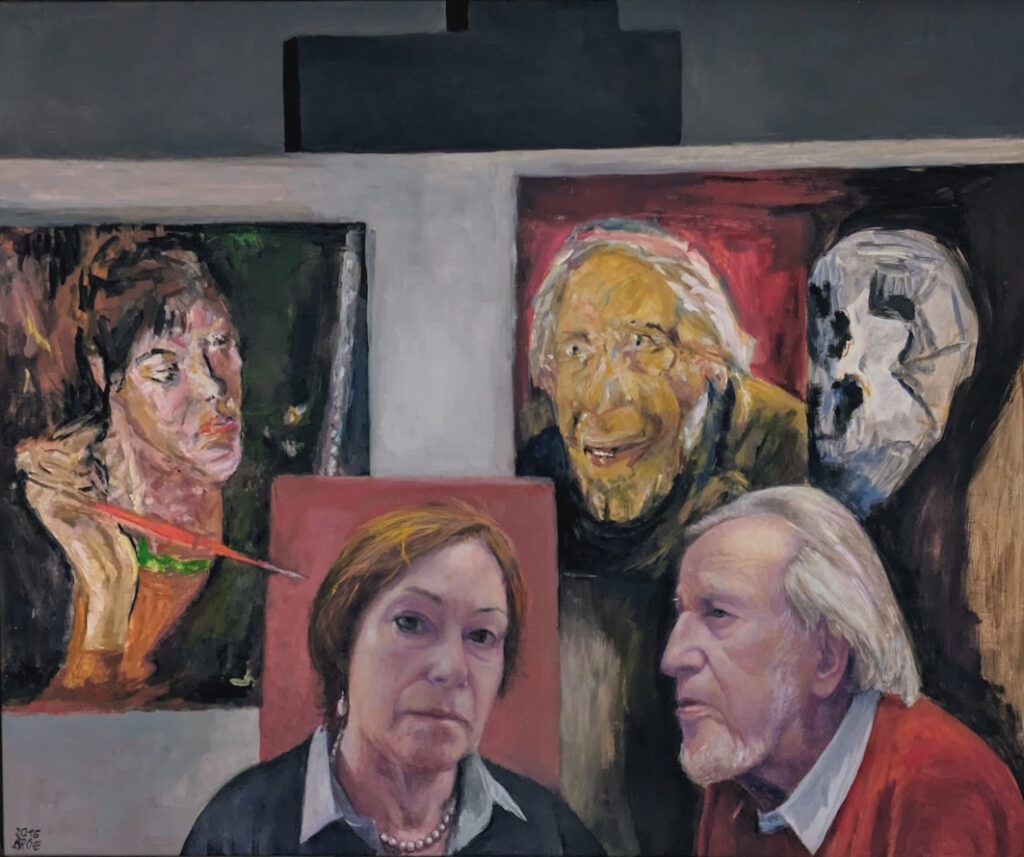
This closes the circle of pictures in this remarkable double exhibition, which I wanted to introduce to you in my opening speech without being able to go into all the pictures individually.
But perhaps there will be an opportunity to discuss this afterwards.
At the beginning of my speech, I said that this year we are honouring Bernhard Heisig, an artist of the century. It’s great that you are starting here in Augsburg – at Galerie Noah, which has long been committed to the artist’s work!
Thank you all very much for your attention.’
Text: Prof. Dr. Bernd Lindner






